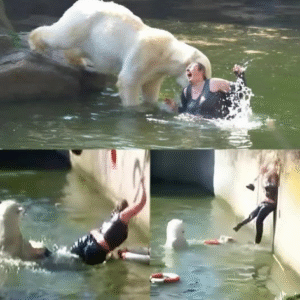Incident at Berlin Zoo: Woman Enters Polar Bear Enclosure
Berlin Zoo, one of Germany’s oldest and most renowned zoological parks, became the center of a shocking and frightening incident when a woman entered the polar bear enclosure. The episode, which unfolded in broad daylight, has drawn attention worldwide due to the potential dangers posed to both the individual involved and the zoo staff who responded.
The Incident Unfolds
According to witnesses, the incident occurred on a busy weekend afternoon when the zoo was filled with families and tourists. A woman, whose identity has not been publicly disclosed, scaled the barrier separating visitors from the polar bear habitat and entered the enclosure. Patrons watched in horror as she walked closer to the massive predator, unaware—or seemingly indifferent—to the extreme danger of her actions.
The polar bear, a fully grown adult, appeared initially curious but quickly exhibited signs of agitation. Zoo officials quickly activated emergency protocols, evacuating nearby visitors and securing the perimeter. Security personnel attempted to distract the bear and draw it away from the woman using noise and visual deterrents.
Response from Zoo Staff
Berlin Zoo staff acted swiftly to prevent a potential tragedy. Zookeepers familiar with the animal’s behavior monitored the situation closely, attempting to guide the woman toward a safer exit without provoking the bear. At the same time, police officers were summoned to assist in managing the incident and ensuring the safety of both the woman and onlookers.
Emergency protocols for large predators in captivity typically include tranquilizer deployment, distraction techniques, and rapid evacuation of human witnesses. In this case, zookeepers prioritized non-lethal methods to prevent escalating the situation, reflecting their training in handling high-risk encounters with dangerous animals.
The Woman’s Actions
Authorities have not yet released a full explanation for why the woman entered the polar bear enclosure. Speculation ranges from an intentional attempt to provoke attention to potential mental health issues. Behavioral experts note that incidents of individuals entering dangerous animal habitats are rare but can be motivated by various psychological or social factors.
A spokesperson for the zoo commented, “This was a highly unusual and dangerous incident. Our priority was to ensure the woman’s safety and that of the animal, as well as protecting visitors. The motivations behind her actions remain under investigation.”
Public Reaction and Safety Concerns
Visitors who witnessed the event described feelings of shock and fear. Parents reported being especially concerned about their children’s exposure to such a dangerous scenario. Social media users quickly shared videos and images of the incident, sparking debates about zoo safety and human behavior.
Many commenters questioned how the woman was able to breach security barriers, highlighting potential weaknesses in visitor control measures. Others praised the zoo staff for their professionalism and quick thinking, which likely prevented a catastrophe.
Legal Implications
Entering an animal enclosure in a zoo constitutes a serious offense under German law. The woman could face charges including trespassing, endangering animals, and creating a public safety hazard. Authorities are investigating the case to determine whether additional charges related to reckless endangerment of visitors might apply.
Zoo officials emphasized that such actions not only put the individual at risk but also jeopardize the welfare of the animal. Polar bears are apex predators, and a confrontation with a human can result in injury or death for either party.
Risks to Humans and Animals
Polar bears are among the largest and most powerful terrestrial predators on Earth. Adult males can weigh up to 1,500 pounds, while females average around 700 pounds. Even in captivity, these animals retain instinctual behaviors that can make encounters with humans extremely dangerous.
Experts note that while zoos provide a controlled environment, wild instincts remain intact. A sudden intrusion into their territory can trigger defensive or aggressive behavior. In this incident, the woman’s entry posed severe risk, not only to herself but also to the bear, which could have been harmed if it reacted violently or if authorities had to use force to subdue it.
Psychological and Sociological Perspectives
Behavioral specialists suggest that incidents like this can result from thrill-seeking behavior, attention-seeking impulses, or impaired judgment. In some cases, underlying mental health conditions may contribute to such risky actions.
Dr. Helena Müller, a psychologist specializing in risk behavior, stated, “People sometimes underestimate the danger of wild animals in captivity. Entering a predator enclosure can be an extreme expression of risk-taking or mental health struggles. Evaluating motivations is essential for both legal and therapeutic responses.”
Social scientists also highlight the role of social media in motivating such incidents. The prospect of viral attention can encourage individuals to engage in dangerous behaviors, particularly in public spaces with highly photogenic or dramatic settings.
Zoo Safety Measures and Lessons Learned
In the wake of the incident, Berlin Zoo announced a review of security measures around high-risk enclosures. This includes increasing physical barriers, reinforcing surveillance systems, and enhancing staff training for emergency scenarios.
Zoo officials emphasized that while most visitors follow rules and maintain safe distances, even a single breach can have catastrophic consequences. Lessons from this event may influence broader policy changes across zoological institutions worldwide.
Preventive measures may include:
-
Improved barriers to prevent climbing or intrusion
-
Clearer signage warning of danger
-
Increased staff presence near high-risk exhibits
-
Emergency response drills for both animals and visitors
Animal Welfare Considerations
Zookeepers also focused on minimizing stress to the polar bear during the incident. Animals in captivity can experience heightened anxiety when confronted with unusual or threatening situations. By prioritizing non-aggressive deterrents and maintaining a calm environment, staff helped protect the bear’s well-being.
Experts stress that repeated incidents of human intrusion can have lasting effects on captive animals, potentially altering their behavior, feeding patterns, and social interactions. Maintaining strict boundaries is critical for the safety and health of both animals and humans.
Conclusion
The incident at Berlin Zoo, where a woman entered a polar bear enclosure, serves as a stark reminder of the inherent dangers of interacting with wild animals, even in controlled environments. The bravery and quick action of zoo staff prevented what could have been a devastating outcome.
Authorities continue to investigate the motivations behind the woman’s actions, while the zoo reviews and strengthens safety protocols to prevent future occurrences. The event has sparked public discussion about responsibility, risk behavior, and the ethical management of wildlife in captivity.
Ultimately, the episode underscores the delicate balance between public access to wildlife and ensuring the safety of both humans and animals. It also highlights the need for ongoing education, vigilance, and preparedness in institutions entrusted with the care of some of the planet’s most powerful predators. While shocking and alarming, the incident may serve as a valuable lesson for zoos and visitors alike about the consequences of crossing boundaries that exist for life and safety.


